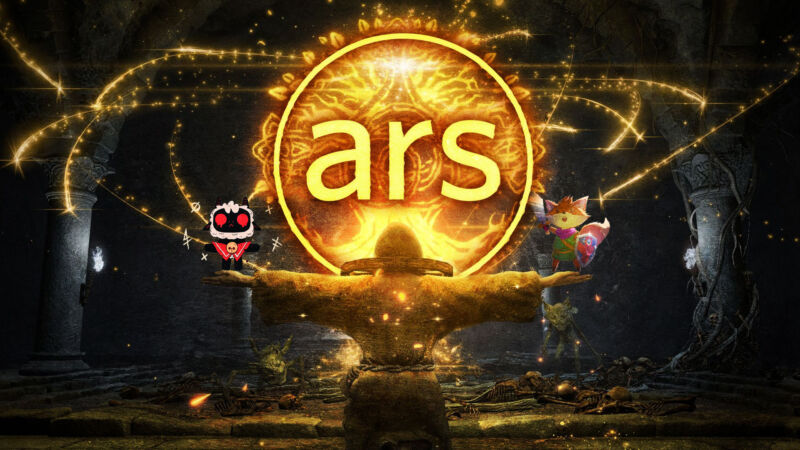
2022 was a bit of a weird year for video games. For a start, quite possibly the most anticipated game of the year came out in March, well ahead of the usual holiday season rush of releases. But that holiday rush was itself muted this year, thanks to delays of big-name franchises from Diablo to Starfield to The Legend of Zelda.
That's led some commentators to call 2022 a "slow year" for a games industry still recovering from the development chaos of COVID. And it's true; we did have some collective trouble getting to our usual selection of 20 games for this year's best games list, a possible sign that there were fewer "obvious" picks than usual.
Looking over the selections that did make the 2022 list, though, it's hard to feel like the collective industry has let us down in any way. The relative lack of big-budget blockbusters allowed plenty of independent games a chance to shine, including those that made this list on the strength of brave new ideas in gameplay or storytelling. All told, the games listed below will stick with us for a long time and speak highly of the game industry's continuing creativity and resilience.
This year we chose to list our gaming picks in alphabetical order, with a single "Game of the Year" pick at the end. Here they are.
Atari 50: the Anniversary Celebration
Digital Eclipse; Windows, Switch, PlayStation 4/5, Xbox One/Series, Atari VCS
It’s rare for a compilation of retro games to be considered for Ars’ annual Game of the Year list. It’s unprecedented for such a game to actually win one of our coveted spots. But Atari 50 does a couple of crucial things to separate itself from the countless classic game emulation collections that have proliferated over the years.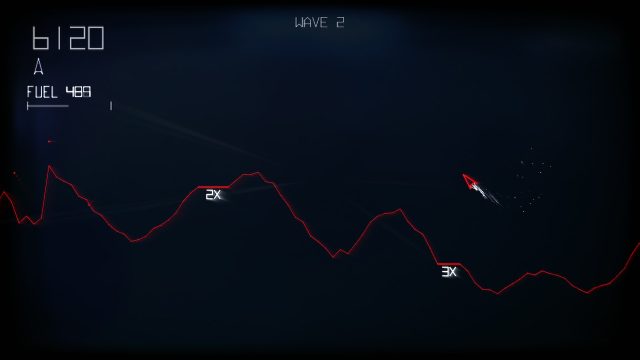
The first is an intense focus on supplementary materials. Atari 50 is packed with video interviews, design documents, contemporaneous advertisements, trivia, quotes, and more. It all gives crucial context to Atari’s 50-year history, and makes even the least playable games in the collection more interesting from a historical perspective. The “timeline” presentation is also top-notch, making the entire product feel more like an interactive museum than a simple collection of old titles.
Atari 50 also shines in its half-dozen “reimagined” versions of a few Atari classics. These feature updated graphics, sound, and gameplay that takes advantage of decades of advances in game design and technology, giving old concepts fresh life for a new audience. While these offerings aren’t all winners, the addictive action of Vctr Sctr alone is enough to warm the heart of any old-school arcade game fan.
-Kyle Orland
Cult of the Lamb
Massive Monster; Windows, Mac, Switch, PlayStation 4/5, Xbox One/Series
Here's a weird statement: There aren't enough cult simulators out there. There are, however, plenty of roguelites. Cult of the Lamb is both, and while it's a good roguelite, it's the cult simulator part of the package that made it stand out this year.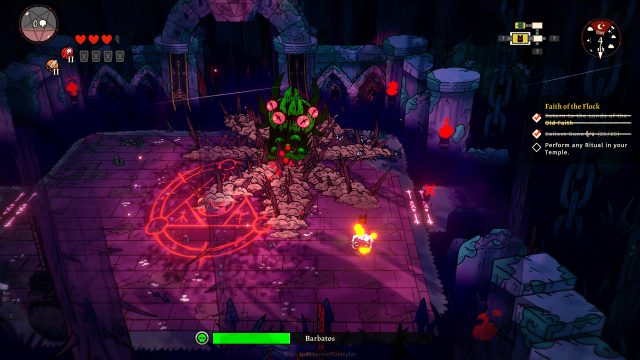
The combat portions of the game play like a more forgiving and accessible cousin to the indie classic Binding of Isaac. The dodge-and-slash action on offer here is tight though nothing too original. But you'll spend at least as much time in a town-building loop in which you'll produce and harvest resources, perform favor quests for townspeople, and manage your cult's general happiness and productivity—all while delivering sermons, silencing heretics, and performing anthropomorphic animal sacrifices.
There are dashes of Animal Crossing, Stardew Valley, and even Peter Molyneux's Black and White in here. It's all quite fun, but the cartoonish vision of running a cult in a world of Lovecraftian horrors is what really sells the game.
The art is top-notch, the music will get stuck in your head (in a good way), and the progression systems are just the right amount of addictive. Cult of the Lamb doesn't reinvent a single wheel, but it's a delicious cocktail of some of the best indie gaming has had to offer over the past few years—whether we're talking about roguelite dungeon crawlers or the cozy game phenomenon.
In other words, it's a "greatest hits" of popular indie game mechanics with a hilarious and original theme. As such, it's worthy of your devotion.
-Samuel Axon
Dwarf Fortress
Bay 12 Games; Windows
The version of Dwarf Fortress that has existed for the last 16 years has been, well, off-putting. The default graphics were colored ASCII characters; onboarding relied on wikis and painful trial-and-error; and the inherent difficulty was also the game's rallying cry: "Losing is fun."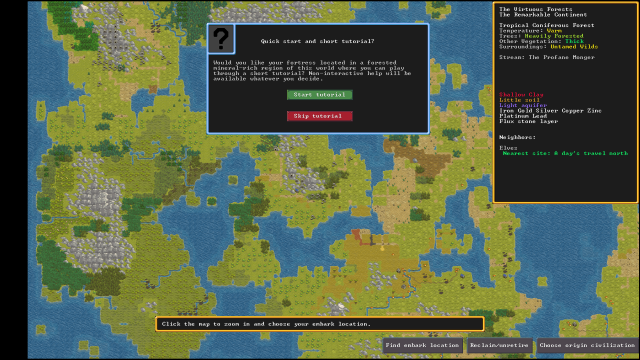
Still, Dwarf Fortress' unmatched complexity and epic storytelling potential gave it a devoted following and kept the game funded with donations—but barely. That makes the game's modern-day "debut”—with 16-bit-style graphics, a wonderful soundtrack, tutorials, and optimized shortcuts—something of an invitation to newcomers. It's also a chance for longtime fans to show their love for Zach and Tarn Adams, the brothers who have kept this crazy simulation running without ever actively selling the game.
The new, commercial version of Dwarf Fortress released this year is much easier to dig than the old version. Now, after your first few attempts at the game, you're more likely to be left with a question like, "How do you find an encampment with sand that also has enough minerals?" rather than "What was that red Turkish-looking symbol and how did it kill my hunter?"
Yet despite the spit-shine, the tremendously deep systems and procedurally-generated mythical chaos are all still here, just with more reasonable ways of accessing and understanding them. (Which leads to another potential question: "Why does that cat get morose when it thinks about tables?") This new version of Dwarf Fortress only adds to the charm of this already-impressive work and will hopefully bring the game to a wider audience that can better sustain it. We’ll all be better for it.
-Kevin Purdy
God of War: Ragnarok
Sony Santa Monica Studio; PS4/5
After four years, Ragnarok could have just provided more of the “Dad of Boy”-style God of War that we remembered and loved back in 2018. That game probably would have been in contention for a spot on this list.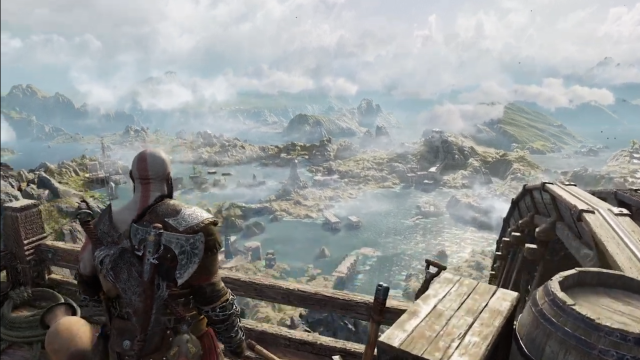
And yes, at its core, much of the gameplay and many of the environments in this sequel will feel familiar to fans of its predecessor. That’s not a bad thing; Ragnarok’s combat systems are as deep as ever, to the point that major new fighting options were being introduced nearly 20 hours into my playthrough.
But Ragnaork also stands on its own, thanks in no small part to its supporting characters. The Norse pantheon implied by the game’s title ably steals the show, trading subtle barbs and mythological drama throughout some delightful, scenery-chewing performances. While the relationship between Kratos and his pre-teen son Atreus doesn’t quite tug on the heartstrings this time around, there are enough intriguing side stories to cover up this relative deficiency.
The sequel does a good job with its varied pacing, too, switching to the nimble, bow-equipped Atreus or to extended puzzle-solving sections before Kratos’ standard axe-and-chain-swinging gameplay can feel too tiresome. And the wonderfully ornate environments shine through, especially on the PlayStation 5, practically begging you to explore every corner for plenty of hidden paths and storylines. Touches like that help push this sequel onto our list, even if it doesn't quite live up to its predecessor.
-Kyle Orland
Horizon: Forbidden West
Guerrilla Games; PS4/5
Horizon: Zero Dawn was a tough act to follow. Made by the developers of the long-running but nonetheless relatively niche Killzone franchise, Zero Dawn was a surprise megahit on the PlayStation, and it found new life with its PC release.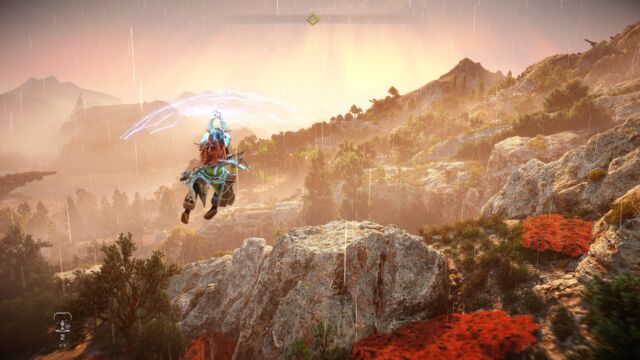
So how do you make a sequel to a game whose whole pitch was about sheer scale and a Lost-like mystery which was largely solved by the game’s conclusion? Guerilla Games' approach with the sequel was to go even bigger. Forbidden West is a post-apocalyptic science-fiction epic that absolutely oozes production values. The open world map is vast, the activities are varied, the motion capture and voice acting are impeccable, the graphics are gorgeous, and the game mechanics are ultra-deep—maybe even to a fault.
Aloy remains one of the most likable protagonists in video games. The strange, far-future world of tribespeople, western American ruins, robot dinosaurs, and parables about tech-industry titans' hubris feels as fresh and relevant as ever. The characters and dialogue are a big step up over Zero Dawn. Everything about the game's artistic and technical presentation is breathtaking, especially on the PlayStation 5. Those are the things that land Forbidden West on this list.
That said, the game's mystery wasn't quite as gripping as its predecessor's was, and the gameplay has too much going on at times, with an unnecessarily bloated equipment system and an overdesigned melee combat overhaul tacked on to the first game's strong bow-and-arrow action and simple RPG mechanics.
These downsides and a lack of innovation in the rapidly evolving open-world genre prevent what seems like a "game of the year" contender from topping our list. Regardless, this is a feast for the eyes, ears, and fingers that you shouldn't miss if you like traditional open-world game design, mega-budget single-player games, or sci-fi storytelling.
-Samuel Axon
Immortality
Sam Barlow/Half Mermaid Productions; Windows, Xbox One/Series, Android, iOS
Whatever happened to Marissa Marcel? That’s the opening conceit of Immortality, ostensibly a searchable collection of raw footage from three “lost” films that were to star Marcel. The little bit of interactivity in the game involves scrubbing through that footage and clicking on items in each scene to jump to related imagery in otherwise unrelated scenes.

At first, meandering through filmed clips feels like a fun journey, following a core cast of actors and producers through fully realized takes on some familiar movie archetypes like the pretentious ‘70s art film; the hard-boiled police procedural; the lightly erotic ‘90s thriller. The behind-the-scenes footage adds an air of intimacy and new perspective on old Hollywood glamor, all rendered in such a realistic style that you’ll forget these full-length movies were created for the game.
As you explore more footage, though, you start getting hints about mysteries and interpersonal drama hidden behind the actors’ polished facades. There isn’t any central crime narrative driving things–as in director Sam Barlow’s previous Her Story and Telling Lies–but there’s just enough oddness under the surface to raise questions.
Then, after hours of scrubbing, a twist comes that recontextualizes everything you’ve seen through a supernatural lens and forcing you to go back and reexamine what you thought you knew. This twist, which I’m intentionally keeping vague for those who haven’t played the game yet, could easily have come off as cheesy or cheap in less-capable hands. But Barlow uses the contrivance to weave a haunting, multi-generational tale that deftly touches on themes of religion, love, and, well, immortality.
While there are plenty of games on this list that I might return to in the coming years, there probably aren’t any whose haunting, complex narratives will stick with me more than Immortality.
-Kyle Orland
Knotwords
Noodlecake Studios; Windows, Mac, iOS, Android
Look, I get why Wordle and its countless clones continue to attract millions of daily players. For this long-time word-game player, though, Wordle’s basic daily guessing game quickly lost its inherent appeal. These days, when I’m looking for some more complex letter arranging, I reach for a few quick Knotwords puzzles.
Anyone who’s gotten hooked on sudoku or crossword puzzles will understand the appeal of Knotwords, which plays out like an addictive combination of both. But Knotwords doesn’t require you to intuit any clever wordplay from the creator, as a crossword does. And the use of whole words, instead of numbers, gives the concept a lot more staying power and variation than a simple sudoku.
Instead, filling out a Knotwords grid requires a careful mix of intuition, knowledge of how English words tend to be constructed, and a willingness to sometimes guess and check, as I noted in my review of the game. It takes a few puzzles to get used to, but once you do, the solving process can lead to the kind of intensely satisfying “ah ha!” moments where the letters just seem to fall into place. For anyone who can appreciate the beauty of letters and words on a grid, it’s hard to do better.
-Kyle Orland
Marvel Snap
Second Dinner; Windows, Android, iOS
With many collectible card games (CCGs), there are big barriers to entry. Thoise barriers include learning the rules–which can be complicated in their own right–but also obtaining the cards needed to be truly competitive, and this requires spending a lot of time or money.

Marvel Snap does a better job than most at fixing these problems. The basics of the game–which involve playing cards that score more points in two of three “zones” over six turns of play–are incredibly easy to grasp after just a few minutes.
More than that, though, Marvel Snap does a great job of balancing things so that newcomers don’t immediately feel outclassed by veterans. While playing more does unlock some more powerful cards, obtaining those cards doesn’t necessarily ensure victory over a “weaker” opponent. Strategic deck building and card placement matter a lot, and battles often rely on intuiting the opponent’s next move or positioning your own as much or more than just drawing the right card at the right time.
Even after dozens of hours, with all or most of the current cards unlocked, there isn’t a single deck that really dominates the meta-game. There are a huge number of card synergies and strategies, some involving pretty intricate card placement, movement, or destruction strategies. And while spending a few bucks can speed up those card unlocks a little bit, the game’s structure means you can unlock them all through normal play without spending a cent on the kind of randomized booster packs that characterize other CCGs.
Add in some excellent art and superhero theming from the Marvel team, and you’ve got a card game that’s easy to learn but hard to master, one that seems sure to have a long life well after 2022 is over.
-Kyle Orland
Mario + Rabbids: Spark of Hope
Ubisoft Milan/Paris; Switch
The original Mario + Rabbids title made little sense, if you tried to actually describe it. "So it's a turn-based, X-COM-style, percentage-to-hit strategy game, which means Mario is dual-wielding plasma pistols and Luigi is a sniper, but also each Mario character has a clone, but it's one of Ubisoft's Rabbids, which are kind of like Minions but more tongue-waggingly stupid?"
However loose an idea on paper, as a set of game mechanics, Mario + Rabbids clicks like a new bike cassette. And Sparks of Hope improves every major aspect of the original that made it such a welcome novelty. It gives your characters even more fluidity on the battlefield, eliminating the square grid and opening up more jumps, dashes, and multi-character combos.
Sparks, star-shaped cherubim that grant stat boosts and new powers, provide depth to characters' damage/tank/support archetypes. The maps are more open, the level design more clever and engaging as you go on, and both the main story (such as it is) and Rabbid-dominated tiny cinematics are goofier than before.
The graphic acuity and smoothness, and between-scene load times, are about as good as they can be on the 6-year-old Switch platform. Half the action takes place in your head, anyways; It's impressive how quickly I came to not just tolerate a character like "Rabbid Peach" but build up an internal legend based on all the times she bailed out my team with her selfie-based healing, overhead rocket launcher, and team jump assists. It's a game that's simultaneously unbelievable and top of its class.
-Kevin Purdy
Perfect Tides
Meredith Gran/Three Bees; Windows, Mac
Mara Whitefish is a pretty average 15-year-old girl. Stuck living year-round on the underpopulated resort island of Perfect Tides, New York, she alternates between terminally bored, unbearably depressed, crushingly lonely, distractedly horny, and consumed by innocent wonder. She also writes fan fiction on the 2000-era Internet, argues with a brother and mother, struggles with unbearable grief, and fumbles her way through some incredibly awkward social situations (both real and virtual) as she wastes away the days.

This might not seem like the most gripping setup for a point-and-click adventure game. Yet the virtual year I spent in Perfect Tides was indeed one of the most compelling game narratives I experienced in 2022.
The insightful and funny writing of Octopus Pie creator Meredith Gran is a big part of the reason, as are the surprisingly detailed pixel animations of the Perfect Tides residents. Unlike most adventure games, the usual pixel-hunting and counter-intuitive puzzle solving isn’t in service of some fantasy adventure or clever, wacky hijinks.
Instead, this is an immensely grounded game about growing up and all the poignant, pointless, and painful moments that can entail. It is immensely relatable for anyone who grew up as a lonely, melancholy teen, even if they can’t relate to other specifics of Mara’s situation.
By staying grounded in real-world concerns, Perfect Tides ended up being more effective and affecting than any power fantasy I played this year. The hours I spent wandering the game’s setpiece locations will stick with me well past 2022.
-Kyle Orland
Return to Monkey Island
Terrible Toybox; Windows, Mac, Linux, Switch, PS5, Xbox Series
Playing Return to Monkey Island didn't feel like a time machine, it felt like a professionally guided tour of a story-rich realm. The character, charm, and wit of the original are still present but now driven by modern tech and decent budgets, resulting in a breezy, nostalgic-but-not-obsessive romp, with a constant supply of wonderful art, music, and dialogue.
Key to this fluid feeling are the puzzles. They're quirky now, rather than obtuse or grinding, with payoffs for the voice actors and animators rather than the player who guessed at someone's fiendish pretzel logic. Return also offers a lot more guidance, whether through simple mouse-over context or by the game's hint system and "Casual" setting, which can un-stick your game without the "I surrender!" feeling of an online guide. It took me two hours before I needed help, which is my personal record in the adventure game category.
The audience that will get the most out of Return is those actually returning. Familiarity with the story's timing (right after Monkey Island 2: LeChuck's Revenge), Guybrush Threepwood's confident-yet-calamitous tone, and the other returning cast members likely double one's enjoyment. But even if you have to fake it until you make it into the Monkey Island vibe, there's a lot to fall into. The distinctly themed islands, the little joys of changing dialogue options, the beautiful scenery—none of it requires deep knowledge of the series or even adventure games, generally. You're in the hands of experts on this tour; you'd do well to relax.
-Kevin Purdy
Rogue Legacy 2
Cellar Door Games; Windows, Switch, Xbox One/Series
When the original Rogue Legacy was released almost a decade ago, it helped popularize an almost sacrilegious concept: a roguelike with permanent progression. Traditionally, roguelikes start you at square one at the beginning of a “run,” and if you die, you lose all your stuff and have to start over with nothing. Rogue Legacy—one of the first games people began referring to as a “roguelite”—let players keep the gold they plundered during an adventure to upgrade their characters for all future runs. As it turned out, the formula made for an incredibly addictive and satisfying experience.
All of that returns in 2022’s Rogue Legacy 2, as does the original game’s other main shtick—each run, you play as the descendant of your previous character, each with his or her own class and (at times wacky) attributes. The sequel does everything a sequel should, retaining and improving on the original’s 2D platforming-and-combat gameplay while adding tons of new upgrades, weapons, classes, attributes, and (procedurally generated) levels.
Rogue Legacy 2’s slick, cartoony graphics are an upgrade over the original’s pixel art style, and the game’s tight, responsive controls make it a joy to play over long, just-one-more-run play sessions. Rougelites are a dime a dozen these days, but Rogue Legacy 2 is one of the best.
-Aaron Zimmerman
Tunic
Finji; Windows, Mac, Switch, PS4/5, Xbox One/Series
It takes a lot for a Legend of Zelda-style action-adventure game to stand out these days. Don’t get me wrong; the basic sword-and-sorcery fights in Tunic are engaging enough, especially during some intense, screen-filling boss fights. But the moment-to-moment action is of the type you’ve seen in countless other games of its ilk at this point. Alone, it wouldn’t be enough to get the game on this list.
What makes Tunic truly memorable is its soft sense of arcane lore. This is a game that reveals itself painfully slowly, through pages of an instruction booklet that you must find in the game (and which are themselves largely in an indecipherable language). These bits of instruction can unlock new abilities but, crucially, also new knowledge about the game world itself and how it works.
Through this slow drip of information, Tunic evokes the sense of mystery that gamers might have experienced in the pre-Internet days, when snippets from magazines and schoolyard rumors helped round out the mysterious digital worlds on our CRT TV screens. That’s a difficult thing to do in our modern gaming era, where most games feel the need to hold your hand and explain everything in excruciating detail.
Figuring out what makes Tunic’s world tick feels like an achievement that most modern games struggle to even approach. And the journey to obtain that hard-earned knowledge raises this game above its genre companions.
-Kyle Orland
Vampire Survivors
Luca Galante; Windows, Mac, Xbox One/Series, Android, iOS
My favorite game of the year was not a massive, 100-hour RPG or a big-budget action title. It was Vampire Survivors, a cheap, minimalistic indie game.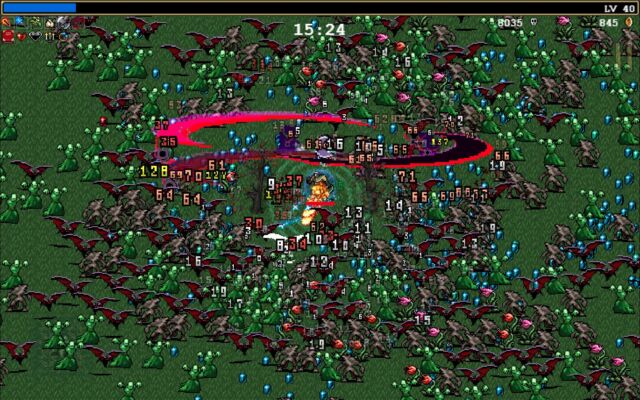
You’d be forgiven for thinking that it doesn’t look like much, but its homage to late-NES sprites and barely-there animations belie the game’s irresistible magnetic pull. This game is addictive—but it’s also weirder and deeper than it might initially seem, and it’s chock full of secrets to uncover.
The gameplay is simple. You walk around while your character auto-fires spells and abilities at ever-escalating hordes of enemies. You can’t directly target your attacks, so you have to position your character to stay safe and make sure your attacks go where you want them to. Defeated monsters drop XP gems, which you pick up to fill your XP bar. Every time you level up, you get a choice between a few new weapons and passive skills. Put together a build powerful enough to let you survive for 30 minutes, and you’ve “won.”
Vampire Survivors took the gaming world by storm when it was released as an Early Access title in late 2021—and then again when it came out properly in October 2022. The game was so popular that it spawned its own genre as indie devs looked to get in on the craze (I have to give a quick shoutout to my favorite from this crop: the stats-obsessed Brotato, which is still in Early Access but which I’ve played even more than Vampire Survivors—it’s excellent).
To top it off, Vampire Survivors costs an absurdly low $4.99, making it the no-brainer video game pickup of the year.
-Aaron Zimmerman
Wordle
Josh Wardle/New York Times; Web
Has it really been only a year since I started playing Wordle? The word-guessing puzzle game was technically made public in October 2021, but it really became a phenomenon at the beginning of 2022. Since then, it has been such a part of my life that I can’t remember a world before it. It has long been integrated into my daily routine—even if I’m now much less obsessed with keeping my daily streak going than I once was.
The game’s immense popularity saves me from having to provide a gameplay summary here, though if you’ve somehow missed the boat and need a rundown, you can refer to our January first impressions.
The game has come a long way since its release. Its creator, Josh Wardle, sold his project to The New York Times in January, and the paper thankfully didn’t mess with the gameplay. The game's new-ish editor has made a few curatorial decisions that worried me—the answer the day before Thanksgiving was an entirely-too-topical DRIVE, and the answer on Thanksgiving was FEAST—but things have returned mostly to normal since.
I don’t share my scores with friends and family every day anymore—though that kind of sharing was a key factor in the game’s initial success. Still, there are very few days that I forget to play. I also play a bit differently now; instead of agonizing over guesses to maximize my bragging rights, I take a more casual tack, making guesses as they come to me and not worrying so much about securing that coveted two-guesser.
I can’t see myself quitting anytime soon—and some blessed day, the letters of my starting word, RAISE, will all turn green on guess one.
-Aaron Zimmerman
Ars Technica’s Game of the Year: Elden Ring
From Software; Windows, PS4/5, Xbox One/Series
There was scarcely a question before its launch that Elden Ring was going to be a hit with core gamers. Elden Ring is the latest and biggest project from the creators of Dark Souls—which was a game so popular with a certain gamer crowd that pointing that out has become a passé joke. Its pedigree and promise for that audience couldn't have been more obvious.
But it actually was surprising when Elden Ring wasn't just a hit among those fans, but it became a global cultural phenomenon. This was a mainstream zeitgeist flash on the level of 2017's The Legend of Zelda: Breath of the Wild, 2011's The Elder Scrolls V: Skyrim, or even 2001's Grand Theft Auto III. Elden Ring seemingly violated every rule of a crossover hit, too; it was punishingly difficult, bafflingly opaque, and relentlessly grim.

Yet here we are. Perhaps it was the timing. 2020 and 2021 were rough years for many of us, full of challenges against which we felt hopeless. Then came Elden Ring, a game that was all about seemingly insurmountable challenges that anyone could ultimately overcome through persistence and patience. Surely there was something satisfying to our pandemic brains about making the impossible gradually seem possible—and ultimately trivial, once you've achieved true mastery.
Dark Souls, Bloodborne, and other games from Elden Ring developer From Software offered that experience too, but the move to an open world design made that long-standing formula more palatable. Early on, Elden Ring teaches players that they can simply walk away from fights they can't win and come back later more powerful and quite a bit wiser to confront those foes again. The go-anywhere design makes JRPG-style grinding a true possibility to increase your power, and the inclusion of horseback combat gives you an edge in many engagements that you simply wouldn't have in the studio's prior titles.
Further, Elden Ring's popularity may have actually made it more accessible. From Software's games have always been known for their clever social features that allow sharing of tips and the like with strangers and friends. Elden Ring expanded on these, while ever-growing wikis and vibrant social media conversations turned every challenge into a group project for many players, softening the blow of tackling the game as an individual.
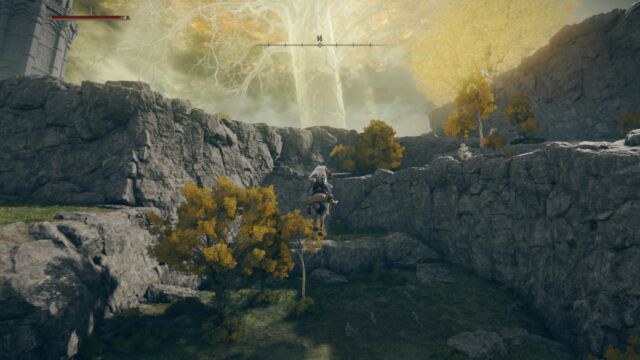
Yet despite all that, Elden Ring somehow retained its predecessors' appeal, and you can enjoy it just as much if you never read a word from anyone else about it.
You also need to account for the game's gripping and gorgeous world, its sparse but impactfully weird characters, its exquisitely designed RPG systems, its fit-as-a-fiddle combat, and its Breath of the Wild-like bucking of open-world design conventions that some feel have grown stale. Wrap it all in a singular, coherent vision and identity, and you have not just the best game of 2022 but also a game that people will remember fondly for many years to come. All told, it's an instant classic. We don't get one of those every year, but we did in 2022. And wow, did we need it.
-Samuel Axon
https://ift.tt/5ftrvD7
Technology

No comments:
Post a Comment